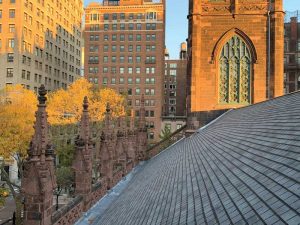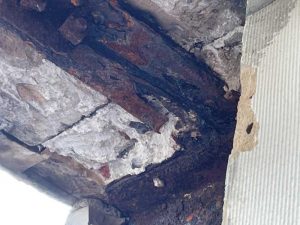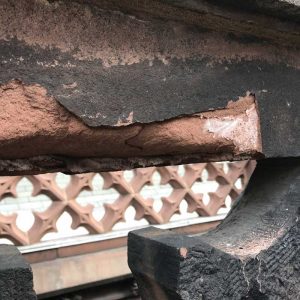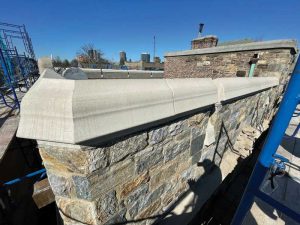
By Richard W. Off, AIA
While repairing and salvaging existing materials is generally regarded as the first choice when addressing deterioration in exterior restoration projects, replacing some amount of material is often unavoidable. When replacement becomes necessary, design professionals are confronted with a critical decision, to match existing materials “in-kind” or to use substitute materials. Using “in-kind” materials is almost always considered preferable, especially amongst preservationists with respect to historically significant buildings. However, the choice of whether to use substitutes can be more complex and nuanced than it might first appear.
Substitute materials are not only used within contemporary restoration projects but also have been employed in construction for many centuries. Additionally, although traditional construction materials are time-tested and there are good reasons for their continued use in many applications, material technology is ever evolving and often improving, as are the codes, regulations, and industry standards which govern their use. Most importantly, there can be situations where the use of substitutes might be the most logical and beneficial choice, resulting from various design and construction circumstances and criteria.
Terminologies
An evaluation of material use within exterior restoration projects requires an understanding of commonly used terminologies, and their synonyms, which may not necessarily mean the same thing. The first is “substitute” versus “alternative.” Both are often used within the industry but there is no officially recognized difference between them. Therefore, for the sake of this article, they shall be considered interchangeable, but substitute shall be used throughout. As for their meaning, using a substitute implies one type of material, product, or system is used in place of another, within a building assembly. This could involve replacement of select units, comprehensive reconstruction of entire areas and, in some cases, building additions, especially those in historic districts.
The next important terms are “existing” versus “original” versus “historic.” Although there are instances where they all mean the same thing, these words are not inherently interchangeable. Existing is the material that is currently present, original is the material used when the building was constructed. Historic is a more ambiguous term which could imply there is cultural or aesthetic value to the original building or material, or it might simply refer to the fact the original construction is dated to a certain era or is no longer employed the same way in contemporary practice. These are important conditions to understand because material replacement always involves existing conditions but does not necessarily involve original or historic materials, as the latter two might have already been replaced in a prior project.

If some original material has been replaced with different materials, the question of which is to be matched must also be answered. It also begs the question, was the previously replaced material appropriate in the first place? Further, it is important to note historic does not necessarily mean traditional, such as stone and wood, as it could be in reference to industrial materials used in 20th century modernist style buildings. Further, traditional construction does not necessarily mean the structure is inherently old. The Basilica of Sagrada Familia in Barcelona, Spain, designed by famed architect Antoni Gaudi, has been under construction for 140 years, and new stone masonry is still being laid per the architect’s original plans. Not to mention, many thousands of vernacular structures around the world are still built using traditional materials.
The next term is not a word, but the phrase “in-kind,” which is frequently employed within preservation projects. Matching “in-kind” is often the desired approach when replacing materials, but what “in-kind” means can be unclear. Does it mean matching original or existing material? Is it matching general appearance like size, shape, color, and texture? Or is it matching physical properties as per ASTM testing or other officially recognized standards? Must the material come from the original source, such as a particular quarry or shop, and does it need to be fabricated the same way?
If materials must match the same type, it is critical to understand not all stone, wood, metal, etc., is created equal. Not only because limestone is not the same as sandstone (for example) but also because even the sourcing, extraction, processing, and classification can affect its quality. Even if replacement material has the same origins, adjacent existing material to remain may have weathered and become altered over time from exposure, so it may be impossible to truly match the properties and appearance of the original or existing material. These questions demonstrate the importance of not relying too much on the phrase “in-kind” without developing detailed criteria for its project-related meaning and providing thorough technical specifications that clarify these ambiguities.

Other important terminologies to consider include those officially recognized within The Secretary of The Interior’s Standards for the Treatment of Historic Properties, established under the National Historic Preservation Act (NHPA). This document defines four different approaches to take when treating historic properties:
- Preservation—focuses on the maintenance and repair of existing historic materials and retention of a property’s form as it has evolved over time.
- Rehabilitation—acknowledges the need to alter or add to a historic property to meet continuing or changing uses while retaining the property’s historic character.
- Restoration—depicts a property at a particular period of time in its history, while removing evidence of other periods.
- Reconstruction—recreates vanished or non-surviving portions of a property for interpretive purposes. (National Park Service, “Four Approaches to the Treatment of Historic Properties”)
Many projects involve one or more aspects of each of these approaches, and the use of substitutes could potentially fall under any of them. However, substitutes are more likely to be entertained when performing the three latter approaches.
Evaluation/assessment
Prior to replacing any material, either “in-kind” or with a substitute, an investigation should be conducted to assess why the material is failing in the first place. Thoroughly assessing the underlying causes of distress allows for a better determination of an appropriate corrective action, which should be performed by a design professional experienced in exterior restoration. This may involve investigation techniques such as visual and hands-on inspection, sounding with a hammer, material sampling and laboratory analysis to determine chemical composition or microscopic deterioration, exploratory probes, or non-destructive testing. Assessment could also include structural, foundational, seismic, or water intrusion investigations, as the cause of distress within materials might be the result of deficiencies in other areas of the building, such as below-grade, concealed, roof, or flashing conditions.

Following the investigation, the existing materials should then be evaluated to assess whether they can be repaired and salvaged. Repairs might involve removal and reinstallation or pinning in-situ if the unit is displaced or anchorage has failed, and patching, grouting, or dutchman (partial replacement of the unit’s material “in-kind” if it is cracked or spalled). It can also include recoating to repair damaged finishes or enhance waterproofing capacity, and cleaning if it is soiled or has biological growth. If repairs are insufficient, and it is decided the best course of action is replacement for cost, aesthetic, safety, or performance reasons, the design professional should only then consider whether it can be replaced “in-kind” or if a substitute should be used.




